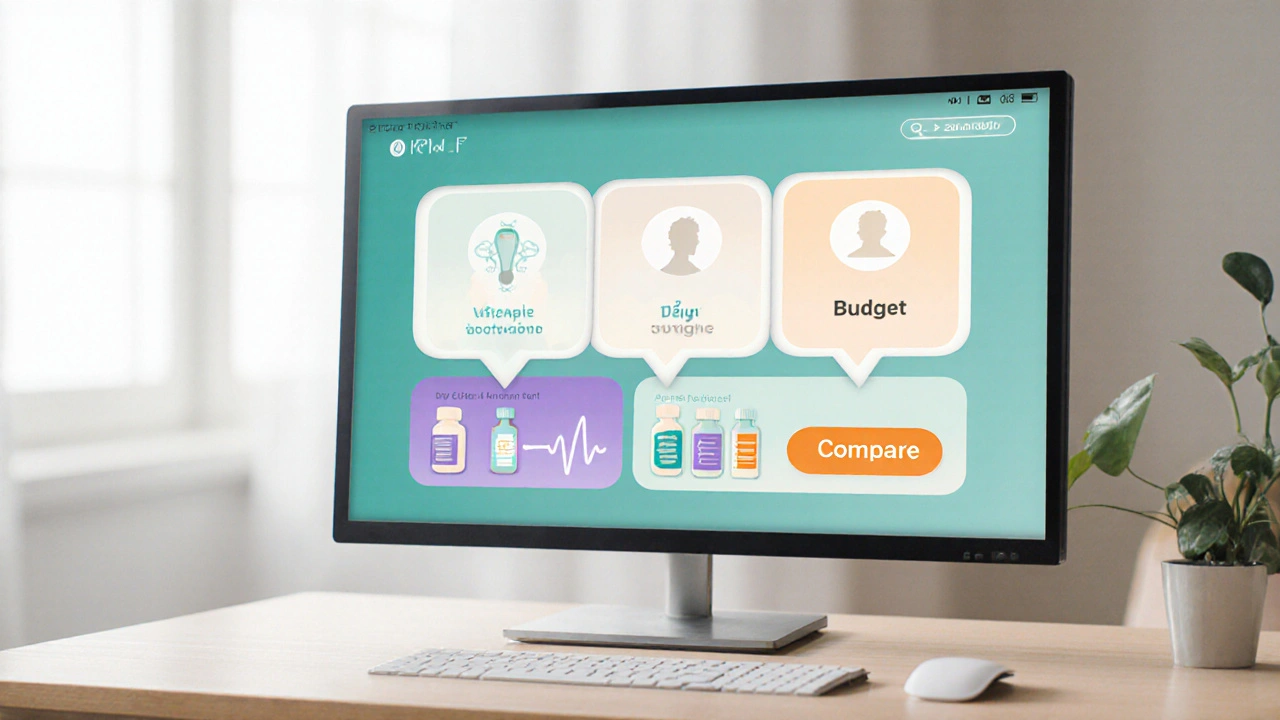Clomid vs Alternatives: Fertility Drug Comparison Tool
Recommended Treatment Options
Quick Takeaways
- Clomiphene (Clomid) is the oldest oral ovulation inducer, but newer options like letrozole and gonadotropins often yield higher pregnancy rates.
- Letrozole works by lowering estrogen, making it a strong choice for PCOS patients and those who don’t respond to Clomid.
- Injectable gonadotropins give the most control over follicle development but require monitoring and are the most expensive.
- Tamoxifen and metformin are niche alternatives, useful when hormone‑sensitive cancers or insulin resistance are concerns.
- Cost, side‑effect profile, and personal health history should drive the final drug choice.
When you’re trying to conceive, the first drug that comes to mind is often Clomiphene (brand name Clomid), an oral selective estrogen receptor modulator used to trigger ovulation. But Clomid isn’t the only game in town. Below we break down the most common Clomid alternatives, compare their mechanisms, success rates, side‑effects and cost, and give you a decision‑making framework so you can pick the right pill or injection for your situation.
What Is Clomiphene (Clomid)?
Clomiphene citrate is a synthetic compound first approved in the 1960s. It binds to estrogen receptors in the hypothalamus, tricking the brain into thinking estrogen levels are low. The hypothalamus then releases more gonadotropin‑releasing hormone (GnRH), which stimulates the pituitary to secrete follicle‑stimulating hormone (FSH) and luteinizing hormone (LH). The surge in FSH/LH pushes one or more ovarian follicles to mature, leading to ovulation about 5‑10 days after the last dose.
Typical regimens start at 50mg daily for five days, beginning on cycle day 3‑5. If ovulation isn’t confirmed, the dose may be increased up to 150mg per cycle.
How Does Clomiphene Work Compared to Other Drugs?
All fertility drugs aim to raise FSH/LH or directly stimulate the ovary. The table later shows where each alternative sits on that spectrum.
- Letrozole is an aromatase inhibitor that reduces estrogen production, causing a similar hypothalamic response as Clomid but usually with a shorter half‑life.
- Injectable gonadotropins are purified FSH (or FSH/LH blends) that bypass the brain entirely and act directly on the ovary.
- Tamoxifen is another selective estrogen receptor modulator, originally used for breast cancer, that can also induce ovulation in certain cases.
- Metformin is an insulin‑sensitizer commonly prescribed for PCOS; while not a direct ovulation trigger, it improves response to other agents.

Key Metrics for Each Option
Below are the core attributes patients and clinicians look at when deciding on a protocol.
| Drug | Administration | Typical Success Rate (Live Birth) | Common Side‑Effects | Average Cost per Cycle (USD) |
|---|---|---|---|---|
| Clomiphene | Oral tablets (50‑150mg) | ≈15‑20% (varies with age & PCOS) | Hot flashes, mood swings, multiple pregnancies | $30‑$60 |
| Letrozole | Oral tablets (2.5‑7.5mg) | ≈22‑26% in PCOS, similar in unexplained infertility | Fatigue, mild bone loss (rare), less multiple pregnancy | $45‑$100 |
| Injectable Gonadotropins | Sub‑cut or intramuscular injection (75‑300IU daily) | ≈30‑40% (depending on protocol) | Ovarian hyperstimulation syndrome (OHSS), bruising at injection site | $600‑$1,200 |
| Tamoxifen | Oral tablets (20‑40mg) | ≈10‑12% (mostly in specific endocrine disorders) | Vision changes, thrombo‑embolic risk (rare) | $40‑$80 |
| Metformin | Oral tablets (500‑1,500mg daily) | Improves overall success when combined; alone ~5‑8% | GI upset, vitamin B12 deficiency with long‑term use | $20‑$50 |
Choosing the Right Drug: Decision Criteria
Not every woman will benefit from the same medication. Use the checklist below to match your profile with the most suitable option.
- Underlying diagnosis. PCOS, unexplained infertility, or a known ovulatory disorder each tilt the odds toward a specific drug.
- Age and ovarian reserve. Women over 35 often need the higher potency of gonadotropins.
- Previous response. If you’ve tried Clomid with no ovulation, moving to letrozole or injectables is logical.
- Risk tolerance. Gonadotropins carry a higher risk of OHSS, while Clomid may cause multiple pregnancies.
- Budget and insurance coverage. Oral agents are vastly cheaper; some plans cover injectables for IVF cycles.
- Side‑effect concerns. Hot flashes (Clomid) vs. bone density worries (letrozole) vs. injection‑site discomfort (gonadotropins).
After you weigh these factors, discuss the shortlist with a reproductive endocrinologist. A personalized protocol often combines drugs-e.g., metformin + letrozole for PCOS-to improve outcomes.
Practical Tips & Common Pitfalls
- Always confirm ovulation with either ultrasound or a luteinizing hormone (LH) test. Skipping monitoring is a major source of treatment failure.
- If you experience visual disturbances on tamoxifen, stop immediately and seek medical advice.
- Take Clomid and letrozole with food to reduce gastrointestinal upset.
- When using gonadotropins, adhere strictly to injection timing; a 12‑hour window can affect follicle growth.
- Track your cycle with a fertility app. Logging basal body temperature, intercourse dates, and medication doses helps your doctor adjust doses quickly.
- Consider lifestyle tweaks-weight loss, smoking cessation, and moderate exercise-because they boost the success of all drugs.
Frequently Asked Questions
Can I switch from Clomid to letrozole without a doctor’s supervision?
It’s best to involve a clinician. Both drugs affect hormone pathways, and the optimal dose depends on your cycle length, BMI, and prior response. A doctor can also arrange the necessary monitoring.
Why do some doctors prefer letrozole over Clomid for PCOS?
Letrozole’s shorter half‑life reduces the chance of lingering estrogen blockade, which translates to fewer multiple pregnancies and a slightly higher live‑birth rate in PCOS patients.
What’s the biggest danger of injectable gonadotropins?
Ovarian hyperstimulation syndrome (OHSS). It can cause abdominal pain, rapid weight gain, and in severe cases, fluid accumulation in the chest or abdomen. Close ultrasound monitoring mitigates the risk.
Is metformin effective on its own for getting pregnant?
Alone, metformin has modest success (5‑8%). It shines when combined with ovulation drugs, especially in insulin‑resistant PCOS, where it improves ovulation rates and reduces miscarriage risk.
How long should I try a medication before deciding it’s not working?
Most clinicians recommend 3‑6 cycles of an oral agent before switching. If you’ve had no ovulation on ultrasound after three attempts with rising doses, discuss moving to letrozole or injectable therapy.
Choosing between Clomid and its rivals isn’t a one‑size‑fits‑all decision. By understanding how each drug works, its success metrics, and your personal health profile, you can team up with your doctor to craft a plan that maximizes your chances of a healthy pregnancy.


Molly Beardall
October 4, 2025 AT 03:51I just read the whole Clomid vs alternatives breakdown and I’m feeling like I’ve been thrown into a hormonal tornado. The way they list success rates feels like a cruel joke when you’re staring at a blank calendar and a ticking clock. Every drug sounds like a promise, yet the side‑effects list reads like a horror movie script. Clomid with its hot flashes and mood swings can turn a simple morning into a sweat‑laden drama. Then there’s letrozole, the so‑called PCOS savior, but who knows if the bone loss risk will haunt you later? Injectable gonadotropins boast the highest numbers, but the cost alone could bankrupt a small family, not to mention the constant injections that feel like you’re poking a balloon with a pin. Tamoxifen? Only if you have a history of hormone‑sensitive cancer, which most of us don’t even think about until it’s mentioned. Metformin is tossed in as a niche option, yet it’s really just a sugar‑lowerer trying to join a fertility party. The table of numbers is nice, but it hides the emotional roller‑coaster you ride with each cycle. I love the quick tips at the end, but “track your cycle with an app” sounds like a gimmick when you’re already overwhelmed. The mention of lifestyle changes is spot‑on, though it feels like a guilt trip for anyone already struggling. And the FAQ section? It reads like a therapist’s script, trying to calm nerves while actually reminding you of all the things that could go wrong. Honestly, the whole article leaves me both informed and terrified, as if I’ve just been handed a map to a treasure that’s guarded by a dragon. Still, I appreciate the thoroughness, even if I’m left clutching my pillow at night, wondering which path to take. Definately, I’ll be talking to my doctor with this in hand, hoping for a clear direction.
Brian Pellot
October 4, 2025 AT 18:00Great job laying out all the options! It’s super helpful to see the pros and cons side‑by‑side. If you’re feeling stuck, start with the drug that fits your budget and health profile, then adjust as you go. Remember, monitoring is key – a quick ultrasound can save a lot of frustration later. Keep your spirits up – you’ve got a solid plan now.
Patrick McCarthy
October 5, 2025 AT 09:16Letrozole seems promising for PCOS.
Geraldine Grunberg
October 6, 2025 AT 00:33Absolutely, the breakdown really helps, especially when you consider the side‑effects, which can be a deal‑breaker, and the cost, which can be a major factor, too. I appreciate how each drug’s mechanism is explained clearly, so you don’t have to hunt for extra sources. The table format makes comparison painless, and the quick takeaways are perfect for a fast skim. Overall, a very balanced piece.
Elijah Mbachu
October 6, 2025 AT 15:50I like how the article stresses monitoring – it’s easy to overlook but vital. Also, the lifestyle tips are a nice reminder that meds aren’t the only piece of the puzzle. Balancing work, stress, and treatment can feel overwhelming, but small changes add up.
Sunil Rawat
October 7, 2025 AT 07:06From an Indian perspective, many couples start with Clomid because it’s affordable and widely available, but we’re seeing a shift toward letrozole as doctors share more data. Cultural expectations around family planning can add pressure, so having clear information like this is a blessing.
Andrew Buchanan
October 7, 2025 AT 22:23The success rates listed align with most recent studies, and the cost breakdown helps when budgeting for treatment cycles. Monitoring ovulation remains essential regardless of the drug chosen.
Krishna Chaitanya
October 8, 2025 AT 13:40Wow, those numbers are a roller‑coaster! Imagine the hope when you read a 30% success rate, then the dread of the cost; it’s a dramatic tug‑of‑war on the heart.
diana tutaan
October 9, 2025 AT 04:56The article glosses over the real drawbacks of injectables – the risk of OHSS is not a footnote, it’s a serious concern that many clinics downplay.
Sarah Posh
October 9, 2025 AT 20:13Stay hopeful! Even if the journey feels steep, many find success after adjusting the protocol. Keep leaning on your support system and trust the process.
James Knight
October 10, 2025 AT 11:30Honestly, this whole “choose your poison” vibe just adds more stress. People already feel like they’re on a treadmill of hope and disappointment.